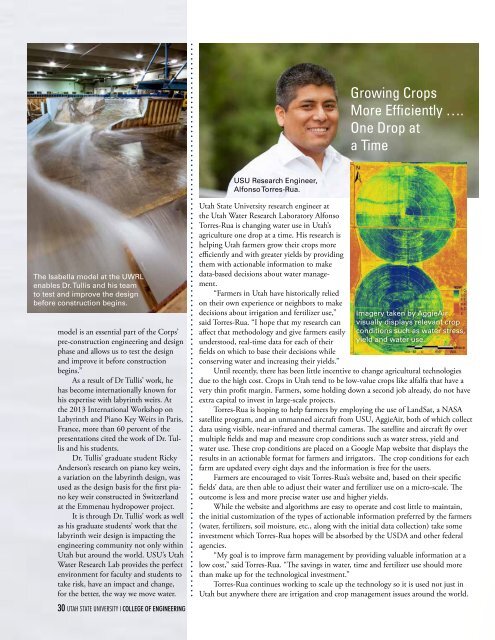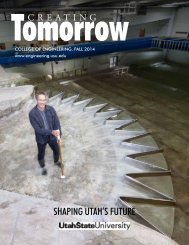Tomorrow
Create successful ePaper yourself
Turn your PDF publications into a flip-book with our unique Google optimized e-Paper software.
Growing Crops<br />
More Efficiently ….<br />
One Drop at<br />
a Time<br />
USU Research Engineer,<br />
Alfonso Torres-Rua.<br />
The Isabella model at the UWRL<br />
enables Dr. Tullis and his team<br />
to test and improve the design<br />
before construction begins.<br />
model is an essential part of the Corps’<br />
pre-construction engineering and design<br />
phase and allows us to test the design<br />
and improve it before construction<br />
begins.”<br />
As a result of Dr Tullis’ work, he<br />
has become internationally known for<br />
his expertise with labyrinth weirs. At<br />
the 2013 International Workshop on<br />
Labyrinth and Piano Key Weirs in Paris,<br />
France, more than 60 percent of the<br />
presentations cited the work of Dr. Tullis<br />
and his students.<br />
Dr. Tullis’ graduate student Ricky<br />
Anderson’s research on piano key weirs,<br />
a variation on the labyrinth design, was<br />
used as the design basis for the first piano<br />
key weir constructed in Switzerland<br />
at the Emmenau hydropower project.<br />
It is through Dr. Tullis’ work as well<br />
as his graduate students’ work that the<br />
labyrinth weir design is impacting the<br />
engineering community not only within<br />
Utah but around the world. USU’s Utah<br />
Water Research Lab provides the perfect<br />
environment for faculty and students to<br />
take risk, have an impact and change,<br />
for the better, the way we move water.<br />
Utah State University research engineer at<br />
the Utah Water Research Laboratory Alfonso<br />
Torres-Rua is changing water use in Utah’s<br />
agriculture one drop at a time. His research is<br />
helping Utah farmers grow their crops more<br />
efficiently and with greater yields by providing<br />
them with actionable information to make<br />
data-based decisions about water management.<br />
“Farmers in Utah have historically relied<br />
on their own experience or neighbors to make<br />
decisions about irrigation and fertilizer use,”<br />
said Torres-Rua. “I hope that my research can<br />
affect that methodology and give farmers easily<br />
understood, real-time data for each of their<br />
fields on which to base their decisions while<br />
conserving water and increasing their yields.”<br />
Imagery taken by AggieAir<br />
visually displays relevant crop<br />
conditions such as water stress,<br />
yield and water use.<br />
Until recently, there has been little incentive to change agricultural technologies<br />
due to the high cost. Crops in Utah tend to be low-value crops like alfalfa that have a<br />
very thin profit margin. Farmers, some holding down a second job already, do not have<br />
extra capital to invest in large-scale projects.<br />
Torres-Rua is hoping to help farmers by employing the use of LandSat, a NASA<br />
satellite program, and an unmanned aircraft from USU, AggieAir, both of which collect<br />
data using visible, near-infrared and thermal cameras. The satellite and aircraft fly over<br />
multiple fields and map and measure crop conditions such as water stress, yield and<br />
water use. These crop conditions are placed on a Google Map website that displays the<br />
results in an actionable format for farmers and irrigators. The crop conditions for each<br />
farm are updated every eight days and the information is free for the users.<br />
Farmers are encouraged to visit Torres-Rua’s website and, based on their specific<br />
fields’ data, are then able to adjust their water and fertilizer use on a micro-scale. The<br />
outcome is less and more precise water use and higher yields.<br />
While the website and algorithms are easy to operate and cost little to maintain,<br />
the initial customization of the types of actionable information preferred by the farmers<br />
(water, fertilizers, soil moisture, etc., along with the initial data collection) take some<br />
investment which Torres-Rua hopes will be absorbed by the USDA and other federal<br />
agencies.<br />
“My goal is to improve farm management by providing valuable information at a<br />
low cost,” said Torres-Rua. “The savings in water, time and fertilizer use should more<br />
than make up for the technological investment.”<br />
Torres-Rua continues working to scale up the technology so it is used not just in<br />
Utah but anywhere there are irrigation and crop management issues around the world.<br />
30 UTAH STATE UNIVERSITY I COLLEGE OF ENGINEERING



